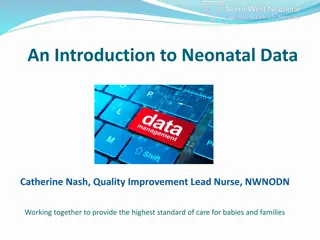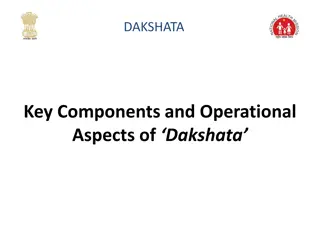Neonatal Nutrition: Growth, Nutritional Support, and Management Phases
Neonatal nutrition, specifically focusing on growth faltering and early nutritional support, is crucial for the well-being of premature infants. Understanding growth rates and providing appropriate nutrients are key goals. Target growth rates and reference growth curves are important considerations. The phases of fluid and nutritional management, including transition, stabilization, and growth phases, play a vital role in ensuring optimal development. This comprehensive approach is essential for promoting neurodevelopment and long-term health outcomes in preterm infants.
Uploaded on Nov 13, 2024 | 3 Views
Download Presentation

Please find below an Image/Link to download the presentation.
The content on the website is provided AS IS for your information and personal use only. It may not be sold, licensed, or shared on other websites without obtaining consent from the author.If you encounter any issues during the download, it is possible that the publisher has removed the file from their server.
You are allowed to download the files provided on this website for personal or commercial use, subject to the condition that they are used lawfully. All files are the property of their respective owners.
The content on the website is provided AS IS for your information and personal use only. It may not be sold, licensed, or shared on other websites without obtaining consent from the author.
E N D
Presentation Transcript
Faculty Brenda B. Poindexter, MD, MS Chief, Division of Neonatology, Children s Healthcare of Atlanta Marcus Professor of Pediatrics, Emory University School of Medicine
Disclosure Brenda Poindexter has documented no financial relationships to disclose or conflicts of interest (COIs) to resolve and has documented this presentation will not involve discussion of unapproved or off-label, experimental or investigational use. Special thanks to Barbara Cormack and Frank Bloomfield my co-authors for a chapter in the 2nd Edition of Nutritional Care of Preterm Infants on this topic
Why is Growth Faltering a Hot Topic? 1. EUGR/PGF not predictive of adverse outcome 2. Based only on weight without consideration of head or length growth, proportionality, body composition, or genetic potential 3. Ignore normal postnatal weight loss 4. Are usually assessed prior to growth slowly of the reference fetus around 36- 40 weeks 5. Are usually based on an arbitrary statistical growth percentile cut-off
Goals of Early Nutritional Support Provide nutrients to approximate the rate of growth and composition of weight gain for a normal fetus of the same postmenstrual age To maintain normal concentrations of blood and tissue nutrients Optimize neurodevelopment and long-term health outcomes *achieving these goals requires an understanding of the intrauterine growth rate to be targeted and of the nutrient requirements of extremely premature infants
Target Growth Rate Weight Interval g/kg/day < 1500 g 17-21 1500-2000 g 14-17 2000-2500 g 12-14 2500-3000 g 10-13 Koletzko, Wieczorek, Domellof, Poindexter, World Rev Nutr Diet 2021
Reference Growth Curves GA (wks) Lubchenco (n=5636) - - 24 0.43% Olsen Fenton (n=3,986,456) 816 1682 3012 0.14% (n=257,855) - 286 889 0.46% 22 23 24 % of cohort
Phases of Fluid and Nutritional Management Phase 1 Transition First 4-5 days characterized by large transcutaneous water evaporation and renal excretion of large excess of extracellular salt and water Expected weight loss of 7-12% (~0.8 SD decrease in Z-score) Phase 2 Stabilization Contraction of extracellular fluid complete Enteral feeding started but not sufficient Variable length of 5-14 days; complete when BW regained Phase 3 Growth Full enteral feedings tolerated; goal to match intrauterine growth
Defining Intrauterine Growth Restriction BW < 3rd percentile OR Any 3 of the following: BW <10th percentile HC <10th percentile Length <10th percentile Prenatal diagnosis of fetal growth restriction Maternal factors such as hypertension or pre-eclampsia Beune, J Pediatr 2018
Defining Growth Faltering Most common definition of extrauterine growth restriction and postnatal growth failure = weight <10th percentile at 36 weeks PMA Experts now calling these terms misnomers (Fenton, J Perinatol 2020) Physiologic weight loss that occurs from extracellular fluid contraction is ~0.8 Z-score decrease in weight, yet most studies of postnatal growth trajectories of VLBW and ELBW infants report much greater decline in weight Z-score in the first 2-3 weeks after birth (Cole, Arch Dis Child Fetal Neonatal Ed 2014) Most longitudinal studies report greater decreases in length and HC Z-scores
A Tale of Two Infants 240/7 wks Birth 580 g 25th -0.68 1 week 550 g 7th -1.44 36 wks PMA 2150g 9th -1.34 Wt %tile Z-score A B Wt %tile Z-score 720 g 74th 0.65 710 g 41st -0.24 2150g 9th -1.34 Chou, J Med Internet Res 2020 peditools.org
Take-home Point Growth faltering describes a change in growth trajectory, not a position on a growth chart at any given point in time
Prevention is the Best Strategy Early parenteral and enteral nutrition Early fortification of human milk Transition period from parenteral to enteral nutrition Standardized Feeding Protocols
Parenteral Amino Acids Minimize Protein Losses in ELBW Infants 105 100 body protein (g) fetus in utero glucose alone 1 g/kg AA 3 g/kg AA 95 90 85 80 75 birth 1 2 3 4 5 6 7 age (days) Denne, J Clin Invest 1996 Poindexter, Am J Physiol 2001
Significance of Early Protein Intake Early protein (and energy) deficits are difficult to recoup and are associated with postnatal growth faltering (Embleton, Pediatrics 1997) Early deficiencies in protein intake contribute to poor growth outcomes (Berry, Pediatrics 1997) Early amino acids improve growth outcomes at 36 weeks PMA (Poindexter, J Pediatr 2006) Positive correlation between protein/energy intake in the first week of life and Bayley MDI at 18 months corrected age in ELBW infants (Stephens, Pediatrics 2009)
Early Parenteral Nutrition PN should be started from the first hours of birth with at least 5.8 g/kg of glucose, 1.5 g/kg AA and less than 2 g/kg lipids Target PN intakes of 3.5 g/kg AA, up to 14 g/kg glucose and up to 4 g/kg of lipids if tolerated *No data to support slow advancement of AAs Do not taper parenteral amino acids before an enteral intake of at least 75 mL/kg has been reached Carnielli, World Rev Nutr Diet 2021
Early Enteral Nutrition Early enteral feedings recommended reduced days to regain BW, days to reach full enteral feedings (Tyson & Kennedy, Cochrane Database Syst Rev 2009) Early progressive feeding increases the number of full enteral feeding days in the first month and reduced days on PN (Salas, Am J Clin Nutr 2018) Faster rates of advancement (30 mL/kg) of enteral feeding does not affect risk of survival without moderate or severe neurodevelopmental impairment (Dorling, NEJM 2019)
Composition of Human Milk 3 Protein Content (g/dL) 2.5 Makers of HMF assume 1.4-1.6 g/dL and do not account for the decrease in protein over time 2 1.5 1 - - Donor milk - - - - - - - - - - - - - - - - - - - - - - - - - - - - - - - 0.5 0 1 2 3 4 5 6 7 8 9 10 11 12 Weeks of lactation
Donor Milk and Growth Ting Ting Fu, MD Fu, Nutrients 2019
Transition from PN to Enteral Nutrition Figure courtesy of Barbara Cormack
Standardized Feeding Protocols Consensus and evidence-based strategies for the provision of early parenteral and enteral nutrition Standardized feeding protocols mediate the impact of perceived severity of illness on decisions related to nutritional support Improved outcomes following implementation include a reduction in time to reach full enteral feedings, decrease in number of days on PN, improved postnatal growth, and reduction in NEC (Patole, Arch Dis Child Fetal Neonatal Ed 2005; McCallie, J Perinatol 2011)
Monitoring for Growth Faltering Measure weight a minimum of 2-3 times/week Measure length (with length board) and HC weekly Convert measurements to Z-scores to monitor change > 2.0 change in Z-score consistent with severe malnutrition Definitions of growth faltering require validation and future studies to determine the target growth pattern to achieve best neurodevelopmental and other long-term outcomes
Causes of Growth Faltering Comorbidities of prematurity associated with poor growth outcomes (NEC, IP, BPD, severe ROP) Therapies such as fluid restriction, diuretics, and systemic steroids Inadequate protein intake (may have low BUN) Sodium depletion (especially with high losses such as ostomy output) suspect if urine Na <20 Zinc deficiency (<10 mol/L) Fat or carbohydrate malabsorption Anemia Increased energy requirement (especially congenital heart disease with left to right shunt)
Sodium Supplementation to Improve Growth RCT of early sodium supplementation (4 meq/kg/d) from day 7 to 35 showed less hyponatremia episodes and greater weight gain (27 vs 23 g/kg/d) in preterm infants (n=53; avg GA 28 wks) Using algorithm for sodium supplementation based on urine sodium concentrations historical control studies have demonstrated improved weight Z-scores (0.32 vs -0.01) (ongoing RCT in preterm infants) Isemann, J Parenter Enteral Nutr 2016 Segar, Am J Perinatol 2018 (NCT03889197) Butterworth, J Pediatr. Surg 2014
Intervention Strategies Higher enteral volumes Recent RCT of higher (180-200 mL/kg/d) vs standard (140- 160 mL/kg/d) feeding volume found improved growth without increase in adverse outcomes (Travers, J Pediatr 2020) Additional HMF Once on full volume feedings, increase to 6 packets HMF/100 mL (27 kcal/oz) with suboptimal growth (add 3 mL liquid protein if mostly donor milk or if length faltering) Liquid protein especially if receiving donor milk If 30 kcal/oz recipe needed, add preterm formula or transition to preterm formula (consider stopping donor milk)
Growth and Long-Term Outcomes Better nutritional support is associatedwith improved growth and less extrauterine/postnatal growth failure Improved growth correlates with improved neurodevelopmental outcomes Linear growth associated with improved neurodevelopment - Increase of 1 Z-score at discharge associated with 8-point increase in language score (Ramel, Neonatology 2012) Better nutritional support is associatedwith improved neurodevelopmental outcomes
Key Messages Growth faltering describes a change in growth trajectory not a position on a growth chart at any given point in time Although most VLBW infants are AGA at birth, postnatal growth faltering remains a common complication of preterm birth A decrease of 0.8 SD in growth parameters over the first few weeks is likely physiologic Although weight gain is important and simple to measure, proportional gains in linear growth and head circumference are essential to optimize outcomes
Key Messages Prevention is the ideal, but when growth faltering does occur, prompt recognition, identification of contributing factors, and appropriate interventions are necessary Future research needed to identify optimal rate of postnatal growth to improve neurodevelopmental outcomes























